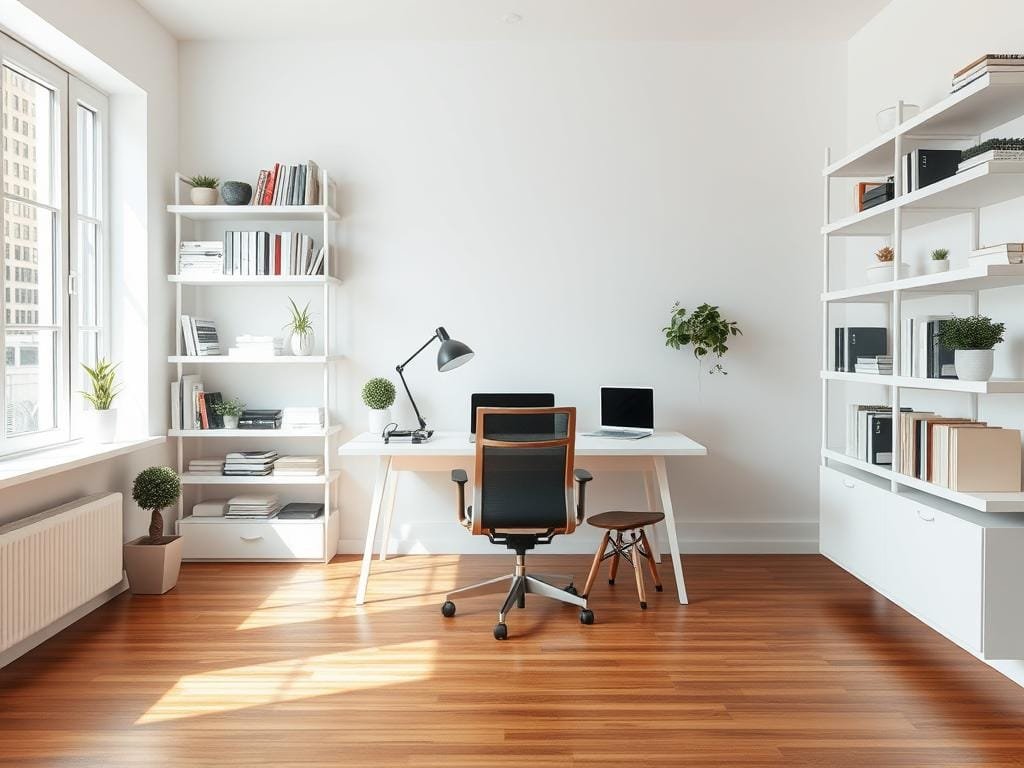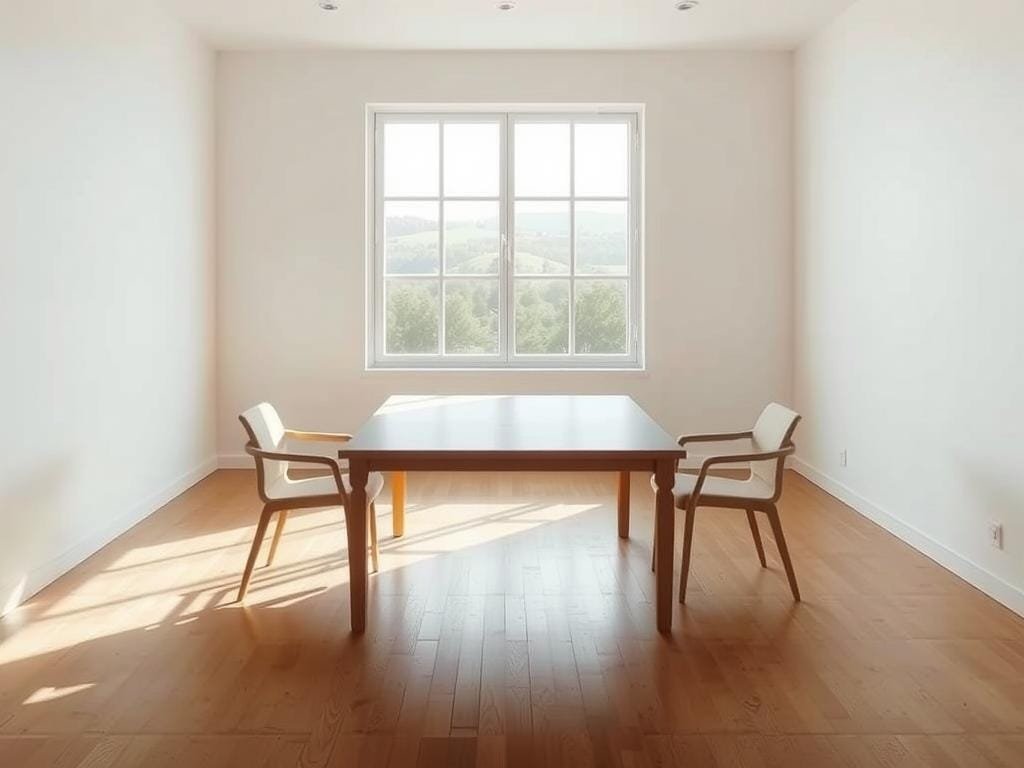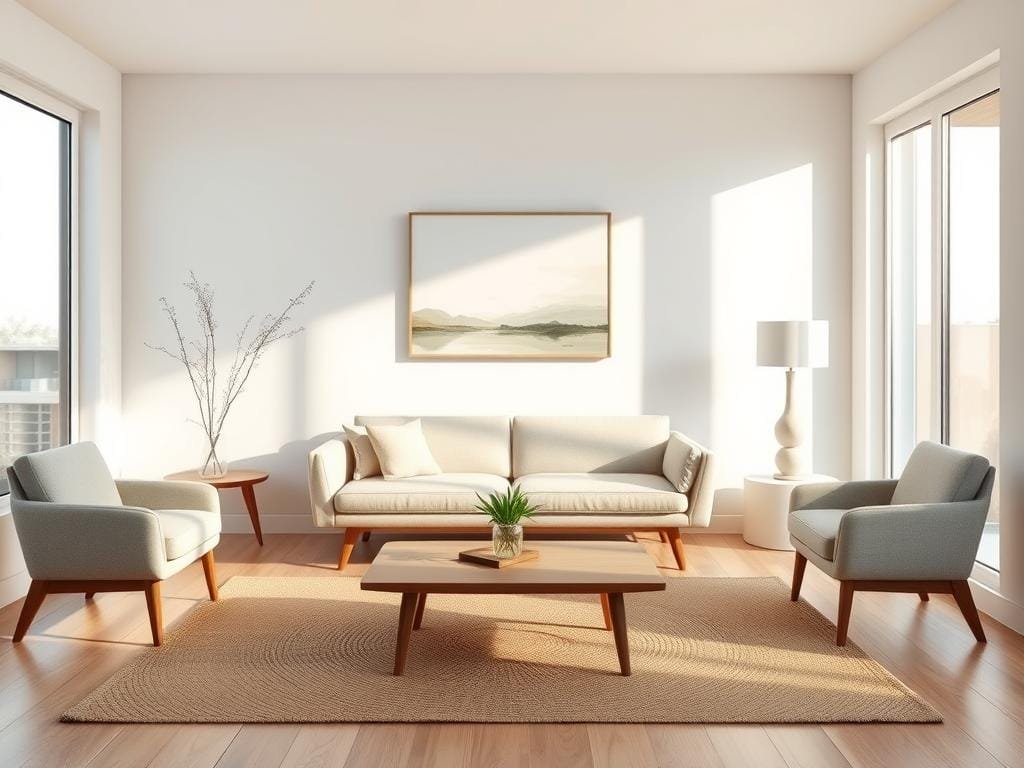Did you know the average American throws away about 4.4 pounds of trash daily? This shows how much waste we produce. But, there’s a shift towards a minimalist lifestyle that values simplicity and clarity.
Living a minimalist life is more than just getting rid of things. It’s about living intentionally and meaningfully. By clearing out clutter, you can feel less stressed, focus better, and be happier overall.
Joshua Michaels’ book “Minimalist Living: Simplify, Organize, and Declutter Your Life” shows how this lifestyle can change you. This article will share the basics of minimalist living. It will also give you tips on how to live simply, be happier, and find a more rewarding life.
Table of Contents
Key Takeaways
- Understand the core principles of minimalist living and its benefits.
- Learn practical strategies for decluttering your physical space.
- Discover how to simplify your digital life and reduce stress.
- Explore the connection between minimalism and mental well-being.
- Find out how to maintain a minimalist lifestyle in the long term.
The Philosophy Behind Minimalist Living
Minimalist living is more than a lifestyle; it’s a way of thinking. It makes you question what’s truly important to you. It’s about clearing your mind and heart, not just your space.
Origins and Evolution of Minimalism
Minimalism comes from old philosophies and cultures. Ancient Greeks believed in living simply. Many indigenous cultures also live in harmony with nature, following minimalism.
In recent years, minimalism became popular. Books like “Minimalism: Live a Meaningful Life” by Joshua Fields Millburn and Ryan Nicodemus helped. They showed how having fewer things can make life more meaningful.
Core Principles of Minimalist Lifestyle
The minimalist lifestyle is based on a few key ideas:
- Simplicity: Keeping life simple, from your home to your daily habits.
- Mindfulness: Being fully present and focused, without distractions.
- Intentionality: Making choices about how you use your time and resources.
- Gratitude: Appreciating what you have, not what you don’t.
Following these principles can lead to a more fulfilling life. It’s about living with purpose and clarity. Minimalism is about creating a life that truly reflects your values.
The Transformative Benefits of Simple Living
Starting a minimalist journey can change your life in many ways. It’s not just about getting rid of stuff. It’s about living a life that’s better for you, your wallet, and the planet.
Mental and Emotional Advantages
Minimalist living is great for your mind. It helps you feel less stressed and more focused. You’ll be able to enjoy life more because you’re not bogged down by clutter.
Living simply also helps you develop healthy habits. These habits improve your mental clarity and emotional strength. You’ll feel calmer and happier in your everyday life.

Financial Freedom
Minimalist living can also make you financially stronger. It teaches you to spend wisely and save more. This way, you can focus on what really matters to you.
It also helps you see what’s truly valuable in life. You’ll stop buying things you don’t need. This leads to a more fulfilling and sustainable lifestyle.
Environmental Impact
Minimalist living is also good for the planet. It encourages you to use less and live more sustainably. Simple actions like reducing waste and using public transport can make a big difference.
By choosing simplicity, you’re not just improving your life. You’re also helping the planet for future generations. Your choices have a positive impact on the world around you.
Assessing Your Current Lifestyle
The journey to minimalism starts with understanding your current lifestyle. Joshua Michaels says knowing your lifestyle is key to living simply. You need to look at your living space and how you consume things.
Identifying Clutter Hotspots in Your Home
Start by walking through your home and finding cluttered spots. These can be your closet or kitchen drawers. Make a mental note or write down where you need to declutter. This helps you know where to begin.

Understanding Your Consumption Patterns
Your buying habits are important for minimalism. Look at what you buy and ask if you really need it. Being mindful of what you buy helps reduce clutter. For tips on healthy habits, check out how to kick-start a healthy lifestyle.
Recognizing Emotional Attachments to Possessions
It’s hard to let go of things because of emotional ties. It’s important to understand these feelings. Are you holding onto something because it reminds you of a memory or person? Acknowledging these feelings is the first step to letting go.
By looking at your lifestyle, finding clutter, understanding your buying habits, and dealing with emotional ties, you’re moving towards minimalism. This journey simplifies your space and leads to a more organized life.
Developing a Minimalist Mindset
Minimalist living is more than just cleaning up your space. It’s about valuing quality over quantity. This change in thinking is key to truly living the minimalist way and enjoying its benefits.

Shifting from Quantity to Quality
Adopting a minimalist mindset means choosing quality over quantity. You focus on items that have real value or bring joy. This approach reduces clutter and increases the worth of what you keep.
For example, instead of buying lots of cheap clothes, invest in a few quality, timeless pieces. This mindset can apply to many areas of your life. It’s about finding true happiness in a few meaningful items, not many less valuable ones.
Practicing Gratitude and Contentment
Gratitude is a big part of the minimalist mindset. By appreciating what you have, you feel content and less tempted to buy more. Reflecting on what you’re thankful for each day can help.
Starting a mindfulness practice also helps. It helps you stay present and enjoy the moment, not always wanting more.
Setting Clear Priorities and Values
Knowing your priorities and values is vital for a minimalist lifestyle. It means living in a way that matches what’s important to you. This helps you make choices that support your goals, not just follow the crowd.
With clear priorities, you can handle the challenges of minimalism better. You make choices that reflect your values, leading to a more organized, clutter-free life.
The Step-by-Step Decluttering Process
Decluttering your home can be easy with a step-by-step plan. You can make your living space more organized and peaceful. Start with small steps and keep going.
Starting Small: The 15-Minute Method
Start with the 15-Minute Method. Spend a short time each day decluttering. This could be sorting a drawer or clearing a shelf. It makes the task easier.
To use this method, set a timer for 15 minutes. Focus only on decluttering during that time. Take a break when the timer goes off. This keeps you motivated.
The Room-by-Room Approach
When you get used to the 15-minute method, try the room-by-room approach. Focus on one room at a time. Declutter and organize it before moving to the next.
Choose a room that’s really cluttered. Sort items into keep, donate, sell, or discard. This way, you tackle the toughest areas first.
Digital Decluttering Strategies
Decluttering isn’t just for physical spaces. It’s also about digital decluttering. Start by organizing your computer files, emails, and subscriptions.
- Unsubscribe from unwanted newsletters and emails.
- Organize your computer files with clear labels.
- Remove unused apps from your devices.
These digital decluttering tips will help you focus better. They reduce digital clutter.
Designing a Minimalist Home
Creating a minimalist home is about finding a balance. It’s not just about getting rid of clutter. It’s about making a space that feels calm and clear.

Essential Elements of Minimalist Interior Design
Minimalist design is all about simplicity and function. Here are key things to think about:
- Simple Color Palette: A few colors can make your home feel calm and connected.
- Natural Light: Using natural light can make your space feel bigger and more inviting.
- Functional Furniture: Pick furniture that does more than one thing to keep your space tidy and efficient.
Color Schemes and Materials
The colors and materials you pick can really change how your home feels. Choose colors that are calming but also interesting. Adding natural materials like wood, stone, and plants can bring warmth and texture.
“The key to a successful minimalist design is not just about eliminating clutter, but also about creating a harmonious balance between form and function.”
Functional Furniture and Storage Solutions
In a minimalist home, every piece of furniture should have a purpose. Look for items that can do more than one thing, like storage ottomans or wall shelves. Here are some storage ideas:
- Built-in Storage: Custom storage can help keep your space tidy and make it look clean.
- Hidden Compartments: Use secret spots to store valuable or personal items.
- Vertical Storage: Use your walls with floor-to-ceiling shelves or storage units.
By using these ideas, you can make a minimalist home that looks great and works well. It will be a peaceful place to escape the daily grind.
Sustainable Living Through Minimalism
Minimalism and sustainable living are closely linked. They encourage a simpler, greener way of life. By choosing minimalism, you declutter and help the planet.
Reducing Waste and Consumption
Minimalism helps cut down on waste and buying. It teaches you to buy less, reducing packaging and waste. Start by thinking before you buy and avoid impulse purchases.
Try buying second-hand or items with little packaging. This helps a lot, as shown in this article.
Eco-Friendly Product Choices
Choosing eco-friendly products is key in minimalism. Pick items that are made to last and are good for the planet. This supports companies that care about the environment.
Look for products made from recycled materials or sustainably sourced wood. These choices help reduce waste and support green companies.
Minimalist Approach to Energy Use
Using less energy is important for a green lifestyle. Simple steps like turning off lights and electronics help a lot. You can also use energy-saving bulbs.
These bulbs use much less power than old ones. Cutting down on energy saves money and helps the planet.
By making these changes, you live more sustainably and inspire others. Every small step towards a simpler, greener life is important.
Practical Organization Systems for Minimalist Living
Effective organization is key to minimalist living. It keeps your space tidy. To do this, you need systems that fit your lifestyle.
Creating Efficient Storage Solutions
Having good storage is vital for a clean home. Look for spaces that are useful and look good. Think about furniture that does more than one thing, like ottomans with storage or beds with drawers.
Tips for Efficient Storage:
- Use vertical space with shelves or units that reach the ceiling.
- Choose furniture with hidden spots for storage.
- Label your containers so you can find things easily.
The One-In-One-Out Rule
The one-in-one-out rule is simple but effective. For every new thing you get, get rid of an old one. It keeps clutter away and makes you think before buying.
“The one-in-one-out rule is not just about getting rid of stuff; it’s about being intentional with what you bring into your life.”
Seasonal Rotation Techniques
Seasonal rotation means storing things you don’t use now and bringing out what you do. It’s great for clothes, decorations, and outdoor gear.
| Season | Items to Store | Items to Retrieve |
|---|---|---|
| Winter | Summer clothing, outdoor furniture | Coats, boots, winter decorations |
| Summer | Winter clothing, heavy blankets | Swimwear, sunglasses, outdoor toys |
Using these systems helps keep your home tidy. You’ll enjoy the simplicity of minimalist living.
Expanding Minimalism Beyond Your Home
Minimalist living isn’t just about your home. It’s about living more intentionally and without clutter. This approach can improve your work life and how you use technology.
Minimalist Approach to Work and Productivity
Working minimally can make you more productive. Focus on what’s important and cut out the rest. This means organizing your work and setting clear goals.
To start, tidy up your workspace. Use software to manage tasks and deadlines. Say “no” to tasks that don’t matter and cut down on meetings.
Simplifying Digital Life and Social Media
In today’s world, keeping your digital life simple is key. This means cleaning up your computer, emails, and social media.
Start by organizing your digital files. Unsubscribe from emails you don’t need and use tools to manage your inbox. On social media, unfollow accounts that don’t matter and limit your screen time.
Mindful Consumption and Shopping Habits
Mindful shopping is a big part of minimalist living. It means thinking carefully before you buy. Ask yourself if you really need something and if it fits your values.
To shop mindfully, wait 24 hours before buying, shop with a list, and choose quality products. Consider a capsule wardrobe or a “one in, one out” rule to keep your belongings balanced.
By applying minimalist principles to work, digital life, and shopping, you can live more intentionally. This approach can make your life more streamlined and fulfilling.
Conclusion: Sustaining Your Minimalist Journey
As you keep moving forward on your minimalist path, remember it’s a journey that needs constant effort and dedication. This journey will bring you long-term benefits in living healthy and feeling well.
To keep up with your minimalist lifestyle, stick to the core principles that led you here. Check your consumption habits and how you feel about your stuff. Make sure they match your values and what’s important to you.
Choosing minimalism means more than just cleaning up your space. It’s about living more mindfully. This way of life helps you stay healthy and balanced. It also makes you feel more connected to yourself every day.

